Understanding and Managing Training Fatigue: From Theory to Practice
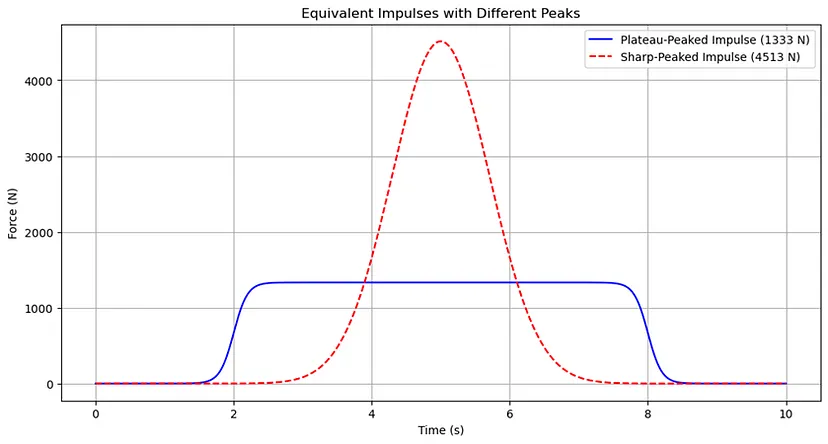
The question of how much training an athlete should do has persisted since the earliest days of organized sport. While it seems simple on the surface, this fundamental question touches on some of the most complex aspects of human performance and adaptation. The evolution of training theory has taken us from simple “train until exhaustion” approaches through percentage-based programs and into the modern era of sophisticated periodization schemes. Yet at its core, effective training still comes down to understanding and managing fatigue.
Fallacy of Modern Throwing Programs
Throwing programs have become a cornerstone of baseball player development. They work –pitchers in the MLB are throwing harder than ever. But beneath these surface-level improvements lies a fundamental problem: most programs take a one-size-fits-all approach that fails to account for individual differences between athletes.
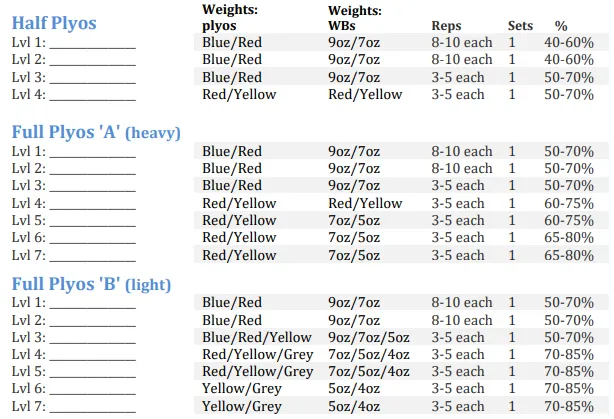
Example of a throwing program designed around a set number of throws.
When asked why their programs work, trainers often point to improved mechanics. When questioned about why velocity phases are effective, they reference the SAID principle — Specific Adaptation to Imposed Demands. The basic idea is that by cycling through periods of increased throwing volume and intensity, you create fatigue that drives adaptation.
This process is arbitrary. How many throws should an athlete make on a velocity day to create optimal results? What level of fatigue should be induced to maximize performance for each individual? How do you scale this process efficiently across a large group of athletes without writing 150 different programs?
Rather than viewing throwing programs as a mechanical fix, we need to start thinking about them in terms of systematic fatigue management. Fatigue drives adaptation. Specific throwing drills matters far less than the adaptation it stimulates. As Joel Jamieson notes in his book Ultimate MMA Conditioning:
“What really matters most is not the exercise you choose or the method you use, but rather the adaptations that result from using and applying them.”
The reality is that modern throwing programs are not designed to create specific stimuli to drive adaptation. There are two primary adaptations possible with throwing work: increasing impulse duration and peak force output. Yet most programs focus on mechanical adjustments, despite the fact that performance data explains more variance in throwing velocity than mechanics alone (data from the Driveline Baseball Openbiomechanics Dataset).

Highest coefficient of determination between POI metrics and HP metrics and Pitch Speed. Outliers and pitches below 70mph were removed.
To develop more effective throwing programs, we need to shift our focus to managing fatigue and driving adaptation in a systematic, individualized way: “The [potential for promoting adaptation of the body] is a relative concept which should be examined and assessed in accordance with the athlete’s current fitness state” (Verkhoshansky & Siff, 2009). This is where autoregulation enters the picture.
Auto Regulation
The Science of Autoregulation
Autoregulation has existed in various forms throughout the history of strength and conditioning. One of the earliest systematic approaches came from DeLorme during his work with injured soldiers. He discovered that allowing patients to adjust their training weights based on their performance in initial sets led to better rehabilitation outcomes than following fixed progressions. This early insight into the value of autoregulation would later influence the development of the Daily Adjustable Progressive Resistance Exercise (DAPRE) protocol by Dr. K.L. Knight in the 1970s (Mann, 2011).
Modern autoregulation methods have revolutionized fatigue management in athletic training, moving beyond rigid predetermined progressions to create dynamic programs that adjust based on individual response. This approach acknowledges that training readiness fluctuates daily due to variations in neuromuscular status, metabolic condition, and psychological factors. Rather than following fixed protocols, autoregulation relies on objective performance metrics to guide training decisions.
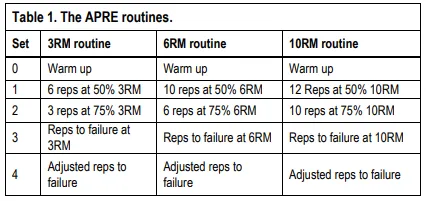
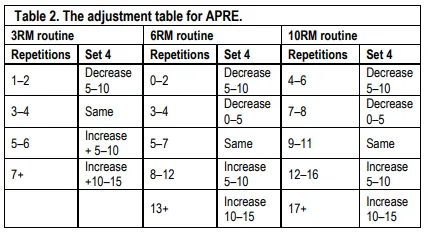
Adjustment charts from APRE (Mann, 2011).
Bryan Mann’s APRE (Autoregulatory Progressive Resistance Exercise) represents one of the most well-developed implementations of these principles in weightlifting. The system adjusts training loads based on 3, 6, or 10 rep maxes, with athletes increasing or decreasing weight based on their performance in the third set (Mann, 2011). This performance drop-off method establishes baseline performance using a 1-rep max, then uses third-set performance to determine fourth-set loading, creating a program that continuously adapts to the athlete’s readiness while motivating performance improvements (Mann, 2011).
These same principles can be effectively applied to throwing programs by monitoring velocity decay. Coaches establish peak velocity for each session, then track performance decline throughout the workout. Training typically continues until performance drops by a predetermined percentage — usually 4–6% for frequency-focused work or 6–10% for capacity-focused training. When performance drops exceed these thresholds, it signals a need for extended recovery between sessions.
Unlike traditional percentage-based programs, this approach automatically adjusts to the athlete’s current state of fatigue and readiness. An athlete in a well-recovered state might perform more volume before reaching the target performance drop, while an athlete carrying fatigue would reach the threshold sooner and stop training appropriately. This self-regulating nature helps prevent both under- and over-training.
Applying Autoregulation to Throwing
The throwing athlete presents unique challenges for fatigue management. Unlike traditional resistance training, where load can be easily quantified and adjusted, throwing involves complex coordination patterns and high neuromuscular demands. However, the principles of autoregulation can be effectively adapted to throwing training through careful consideration of performance metrics and fatigue markers.
The first consideration in applying autoregulation to throwing comes from understanding the relationship between velocity and fatigue. Research has shown that throwing velocity serves as an excellent indicator of both acute and accumulated fatigue. When a pitcher’s velocity drops by a certain percentage from their initial output, it signals significant fatigue that could impact both performance and injury risk. This natural decline in velocity mirrors the performance drop-off principle used in traditional strength training autoregulation.
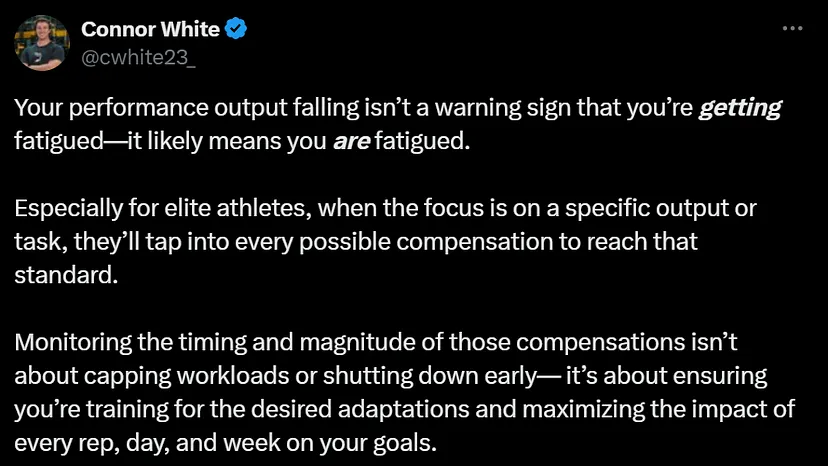
Director of High Performance Connor White discussing autoregulation on Twitter.
DeLorme’s original observations about progressive resistance become particularly relevant when we consider the throwing athlete. Just as his rehabilitation patients needed individually adjusted progressions, pitchers require personalized approaches to volume and intensity. A fixed pitch count fails to account for individual differences in fatigue resistance and recovery capacity, just as a fixed set and rep scheme would fail to optimize resistance training.
Implementing Autoregulation in Throwing Programs
The first challenge in autoregulating throwing programs comes in establishing reliable performance metrics. While velocity provides an obvious parallel to weight in strength training, throwing performance encompasses more than just pure velocity. Command, movement quality, and perceived effort all play crucial roles in overall performance.
The Initial Maximum Effort
Every autoregulated throwing session should begin with establishing the day’s baseline. This doesn’t mean trying to throw as hard as possible on the first throw — that would be both dangerous and counterproductive. Instead, we need a systematic warmup process that builds to finding our true initial maximum for that day. This becomes our baseline for the session, from which we’ll calculate our drop-off thresholds.
Practical Application of Drop-Off Thresholds
In practice, implementing velocity-based drop-off thresholds requires careful attention to both numbers and movement quality. For instance, if a pitcher’s initial velocity is 90 mph, a 6% drop would occur at 84.6 mph. However, we might see mechanical breakdown before reaching this threshold, or we might see command issues while velocity remains relatively stable.
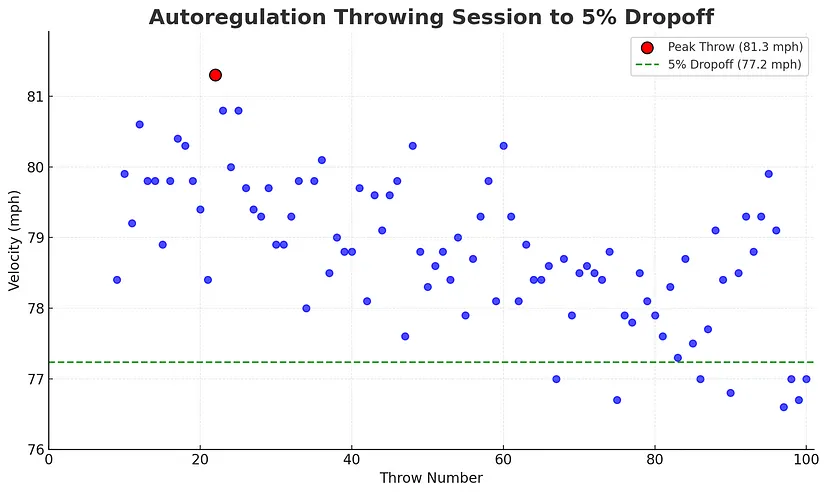
Velocity data from Jack Lambert’s (Director of Baseball Operations at Driveline Baseball) AREG throwing session.
This is where autoregulation becomes more art than science. We need to consider multiple factors:
The first factor is pure velocity drop-off. Generally, we want to cease training when velocity drops below our predetermined threshold. For a singular session on a longer recovery cycle, we might use a higher threshold (around 6% drop), while frequency-focused work on shorter recovery cycles might use a lower threshold (1–3% drop).
The second factor is mechanical efficiency. Even if velocity remains above our threshold, significant changes in mechanics signal fatigue that could lead to compensation patterns or injury risk.
The third factor involves command and movement quality. A pitcher might maintain velocity while losing significant ability to locate pitches or control movement. This often indicates neural fatigue even when raw velocity metrics remain stable.
Understanding Training Response
From Stress to Adaptation
Hans Selye’s work on the General Adaptation Syndrome (GAS) provides the foundation for understanding how the body responds to training stress. According to Selye the GAS is “a generalised effort of the organism to adapt itself to new conditions” (Selye). During the initial alarm phase, which lasts from minutes to hours, performance decreases as the body mobilizes its acute stress response (Selye). The resistance phase follows, lasting days to weeks, during which the body initiates adaptation processes including increased protein synthesis and improved neuromuscular efficiency. If stress continues without adequate recovery, or if a single bout of stress is too extreme, the exhaustion phase occurs, marked by a significant decline in performance that requires extended recovery.
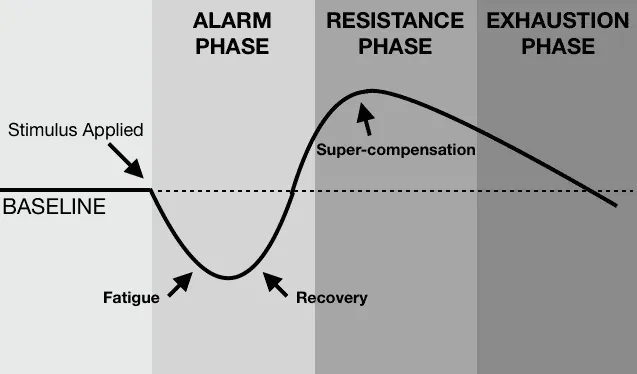
Typical visualization of General Adaptation Syndrome.
While Selye’s model explains the general pattern of adaptation, modern training science has revealed that different systems within the body respond to stress at different rates and with different recovery patterns. Of particular importance is the response of the central nervous system (CNS), which plays a crucial role in athletic performance.
The severity of CNS fatigue provides important feedback about where an athlete is within the General Adaptation Syndrome. When an athlete experiences a performance drop of 1–9% across activities, they’re likely still within the productive resistance phase of GAS — the body is stressed but capable of adaptation. However, performance drops exceeding 10% often indicate the athlete has entered the exhaustion phase, requiring extended recovery to restore normal function.
This relationship between GAS and CNS fatigue has profound implications for training design. A properly structured program must balance the stress needed to drive adaptation with adequate recovery to prevent exhaustion. Understanding these patterns helps coaches distinguish between productive training stress that leads to adaptation and excessive stress that risks pushing athletes into exhaustion.
Central Nervous System Fatigue and Residual Training Effects
Understanding the relationship between CNS fatigue and performance is crucial for optimal training design. CNS fatigue manifests differently from local muscular fatigue, affecting the entire system to “protect the muscle from further peripheral fatigue” (Gandevia, 2001).
When an athlete experiences CNS fatigue, performance typically drops by 1–9% across all activities. This global decrease serves as a key indicator of systemic fatigue — a pitcher might see decreased velocity, but they’ll also see reduced performance in the weight room and diminished explosive power in movements like vertical jumps. This is precisely why many MLB teams use vertical jump testing as a readiness indicator. The vertical jump, while seemingly unrelated to pitching, provides a reliable measure of CNS freshness because it requires high-threshold motor unit recruitment and complex neuromuscular coordination.
The recovery timeline for CNS fatigue follows a predictable pattern based on the magnitude of performance decline:
- For performance drops of 1–9%: Recovery typically requires 1–7 days
- For performance drops exceeding 10%: Recovery may extend to 2–3 weeks
However, this temporary performance decrease doesn’t mean training adaptations are lost. Vladimir Issurin called residual effects “the retention of changes induced by systematic workloads beyond a certain period of time after the cessation of training” (Issurin & Yessis, 2008).
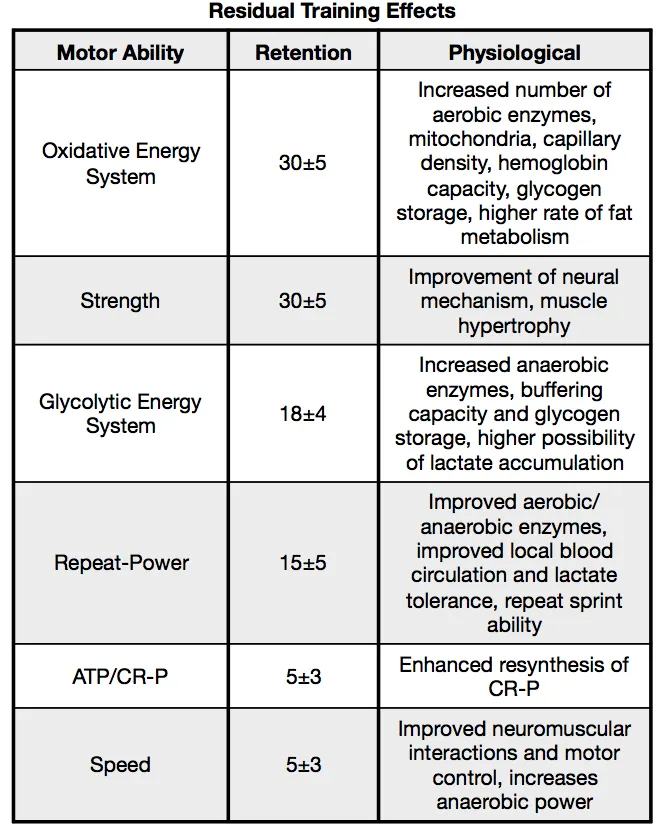
Adapted from: Issurin, V. (2008). “Block Periodization: Breakthrough in Sports Training”
Each motor ability has its own type of residual training effect. For instance, while CNS fatigue from a high-intensity throwing session might clear in 3–5 days, the improvements in max speed can persist without detraining for up to 8 days. These residual effects are based largely on the biochemnical and neural changes that they create: “peak speed is based on very delicate and highly precise neruo-muscular interactions” (Issurin & Yessis, 2008).
The understanding that biological adaptations from fatigue drive performance increases led Issurin to develop block periodization, building on Bondarchuk’s work. The key insight was that by carefully managing training blocks, coaches could time the dissipation of fatigue while maintaining the positive adaptations. This allows athletes to peak at the right time by reducing fatigue while preserving performance gains.
Traditional Periodization Models
The linear periodization model, pioneered by Lev Matveyev, provides a methodical framework for fatigue management in athletic training. This approach begins with high-volume hypertrophy work at relatively low intensities, then systematically reduces volume while increasing intensity throughout the training cycle. The progression culminates in a peaking phase timed to optimize competitive performance (Verkhoshansky & Siff, 2009).
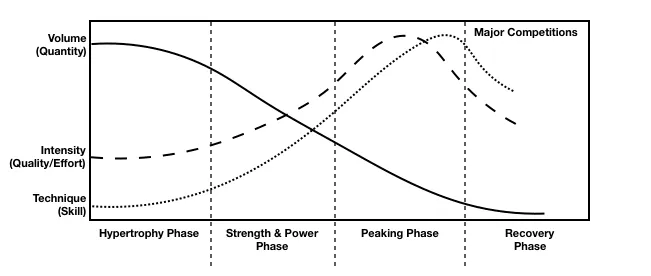
Wave-like basic linear periodization scheme from Lev Matveyev.
While this approach has produced results for many athletes, it fails to account for individual recovery patterns and may not effectively maintain all training qualities throughout the program. The rigid structure can be particularly problematic for athletes in sports requiring year-round performance of multiple fitness qualities.
Undulating periodization emerged as an alternative approach, varying training stimuli more frequently to better maintain multiple fitness qualities. Instead of progressing linearly through training phases, undulating periodization alternates between different types of training stress either daily or weekly. This more frequent variation often proves better suited to athletes needing to maintain multiple performance qualities simultaneously, though it still relies on predetermined progressions rather than individual response.
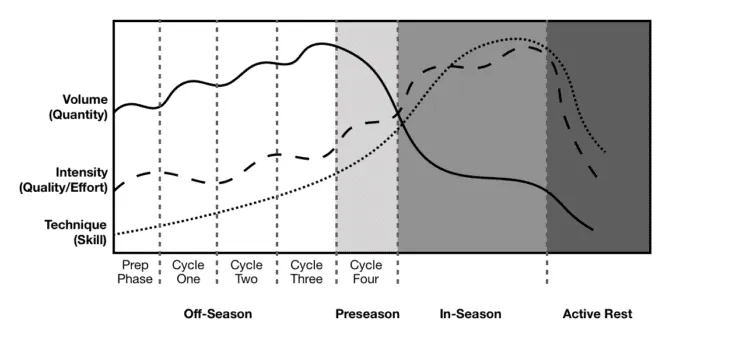
Typical undulating periodization scheme. As intensity increases volume tends to decrease. Both generally increase over the macro-cycle, but this undulating relationship is still observed.
Block periodization, created by Dr. Bondarchuck, takes yet another approach by concentrating training loads for specific qualities in focused blocks. This system begins with an accumulation block emphasizing work capacity and technical development, followed by a transmutation block converting general abilities to sport-specific qualities, and concluding with a realization block for peaking performance (Issurin & Yessis, 2008). While more sophisticated than linear progression, this approach still doesn’t fully address individual variation in fatigue response and recovery.
Fatigue and Periodization
At its core, periodization is about strategically managing fatigue to optimize adaptation. While traditional periodization models focus on long-term fatigue management, modern throwing programs require a more nuanced understanding of how fatigue accumulates and dissipates across different timeframes.
The Two Faces of Fatigue
Training creates both acute and residual fatigue. Acute fatigue manifests as temporary performance decreases within a single session, while residual fatigue accumulates across multiple sessions and can take weeks to fully dissipate. The art of periodization lies in balancing these different types of fatigue to create optimal training effects.
Linear periodization manages this balance through systematic reduction in volume over time. As volume decreases, the accumulated residual fatigue begins to dissipate, allowing adaptations to become fully expressed. Think of it like slowly lifting your foot off the brake pedal — as fatigue (the brake) reduces, performance naturally rises.
Undulating periodization takes this same principle but applies it on a smaller scale. Rather than waiting weeks or months for fatigue to dissipate, undulating approaches create mini-cycles of accumulation and realization. Wave loading provides a perfect example: heavier sets create both fatigue and a potentiation effect, while subsequent lighter sets allow some fatigue to clear while taking advantage of the potentiation.
Application to Throwing Programs
This understanding of fatigue management translates directly to throwing program design through two distinct phases: accumulation and intensification.
The Accumulation Phase
During accumulation, we deliberately build residual fatigue through frequent exposure to throwing stress. This phase typically employs what Buchenholtz termed “frequency toleration,” where weekly velocity drops of around 6% are distributed across multiple sessions. For example:
Example of a frequency toleration phase in a throwing program.
This distribution creates a wave-loading effect within the week — another example of undulating periodization principles at work. The varying daily demands (2% vs 1% vs 3%) allow partial recovery between sessions while maintaining consistent adaptive stress.
The power of this approach comes from its frequency. Many pitchers never experience high-intensity throwing three times per week outside of structured training programs. This novel stimulus, while fatiguing, creates powerful adaptations when properly managed.
The Intensification Phase
The intensification phase shifts focus from distributed stress to concentrated loading: “the goal here is to teach our system how to tolerate relatively immense fatigue” (Buchenholz, 61). Rather than spreading a 6% weekly drop across multiple sessions, we might see a single session creating the 6% drop. This appears counterintuitive — how does a larger acute drop represent “intensification”?
An example of a capacity phase in training, also called intensification.
The answer lies in residual fatigue. As the accumulated fatigue from the frequency phase dissipates, the athlete’s true capacity for intensity emerges. The larger acute drops possible during this phase reflect not greater fatigue, but rather greater access to the athlete’s enhanced capacity developed during accumulation.
Think of it like removing sandbags from a hot air balloon. The accumulated fatigue from the frequency phase acts like sandbags, limiting how high (intense) we can go. As this residual fatigue dissipates during the intensification phase, we can access higher absolute intensities even though each session creates more acute fatigue.
Concurrent Linear Periodization
Beginners benefit uniquely from training with a full spectrum of implements, from very light to very heavy balls. While this might seem counterintuitive — wouldn’t it be simpler to master one implement first? — there are several key reasons why concurrent training accelerates development in novice throwers.
First, beginners have not yet developed stable attractor states or force application strategies. By exposing them to different implements early, we help them discover and explore various ways of generating force. Heavy implements teach them the importance of maintaining positions and relaxing into throws, while light implements help them understand sequencing and the role of speed in force production. This varied exposure prevents them from becoming overly reliant on a single strategy.
Think of it like learning a new language — young children often pick up multiple languages simultaneously more easily than adults learning sequentially. Their neural systems are more plastic and adaptable, allowing them to internalize different patterns in parallel. Similarly, novice athletes can more readily develop multiple throwing qualities simultaneously before movement patterns become deeply ingrained.
Additionally, beginners typically respond positively to any proper training stimulus — a phenomenon often called “beginner gains.” Their bodies are primed to adapt to new stresses, allowing them to improve across multiple physical qualities at once. A pitcher who has never trained systematically before might simultaneously:
- Develop better positional strength with heavy implements
- Improve mechanics and sequencing with standard balls
- Enhance rate of force development with lighter implements
Novice athletes have significant headroom for improvement across all physical qualities, making concurrent development both possible and beneficial. Research has shown that “the improvement of relatively lower athletic abilities doesn’t require highly concentrated training workloads” (Issurin & Yessis, 2008). This allows coaches to develop a broad base of physical capabilities and movement competencies that will support future specialization. It’s why throwing programs should be structured differently for college freshmen versus elite pitchers.
However, this concurrent approach becomes less effective as athletes advance. More trained athletes have already harvested their “beginner gains” and require more focused stimulus to continue progressing. Their neuromuscular systems have adapted to general training stress, necessitating more specific overload to drive further adaptation. This is when transitioning to vertical integration, with its emphasis on developing specific qualities while maintaining others, becomes crucial for continued development.
Understanding this progression — from concurrent development in beginners to more focused training in advanced athletes — helps coaches structure long-term athlete development more effectively. It explains why seemingly complex training with multiple implements can accelerate learning in novices, while also clarifying when and why training emphasis needs to become more specialized as athletes advance.
Vertical Integration
While concurrent linear periodization allows athletes to develop multiple physical qualities simultaneously, this approach has limitations — particularly for more advanced athletes who have moved beyond beginner gains.
This is where vertical integration, also known as conjugate periodization, provides a crucial framework for advanced development. This approach recognizes that significant adaptations in force production capabilities — both peak force and force duration — require focused, sequential training phases rather than concurrent development. As Issurin and Yessis (2008) note, “highly concentrated workloads for many qualities cannot be managed at the same time.” While throwing velocity depends on multiple physical qualities, trying to improve them all simultaneously becomes ineffective for advanced athletes. Instead, strategically emphasizing different qualities in sequence, while maintaining others through supporting work, allows for systematic development of both impulse peak and duration characteristics.
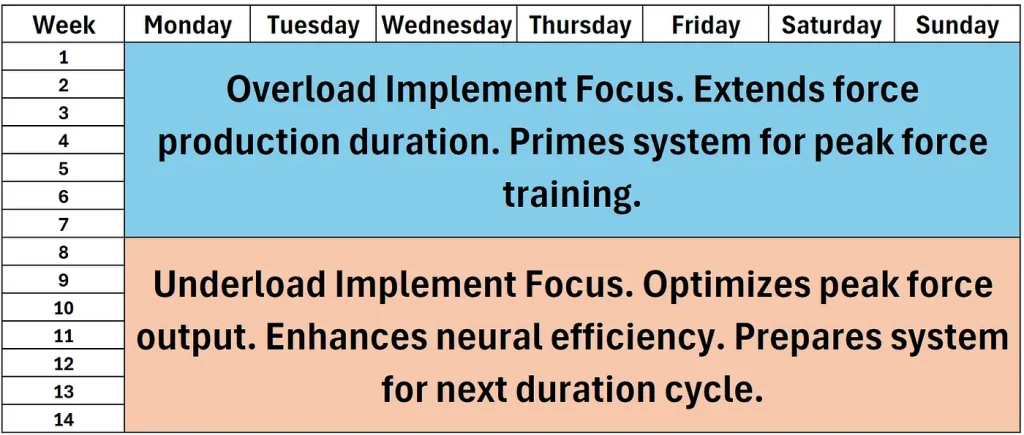
Vertical Integration for different phases in a typical throwing program. Each phase has a specific quality that will yield specific adaptations.
As Verkoshansky explains in Supertraining, the power of vertical integration lies in how “each concentrated load with one emphasis acts as the foundation for the next load with a different primary emphasis, so that pronounced adaptation occurs.” This creates a building block effect where improvements in one quality lay the groundwork for developing the next.
The building block effect of vertical integration is particularly evident in how different impulse characteristics enhance each other. When an athlete improves their ability to sustain force output for longer durations, they develop the foundation to generate higher peak forces. Similarly, as they increase their peak force capabilities, they become better equipped to maintain submaximal forces for extended periods. This creates a positive feedback loop — enhancing duration improves the potential for peak force development, while greater peak force capacity makes it easier to sustain force output for longer periods.
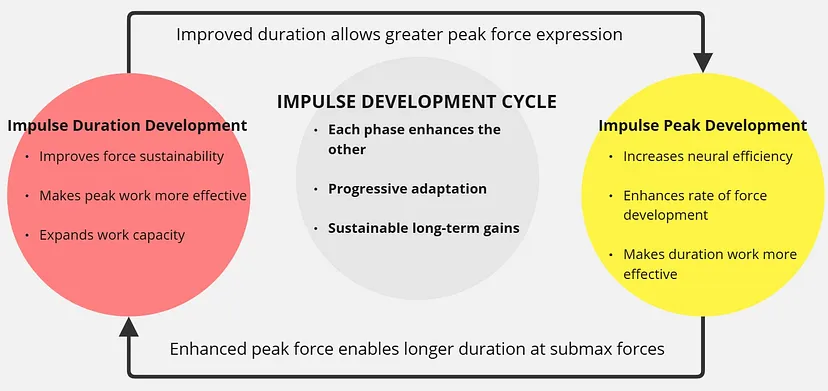
Peak and duration impulse training create a continuous cycle of development in throwing athletes. This diagram shows how each quality supports and enhances the other, leading to sustainable long-term performance gains.
The key to implementing vertical integration effectively comes from understanding how different training implements create distinct force-time profiles. Every throwing movement requires a specific impulse — the area under the force-time curve — to achieve the desired velocity change (previous blog discussing this concept in more depth).
However, this impulse can be achieved through different force application strategies, with each approach developing specific athletic qualities. By strategically selecting and sequencing these different methods, coaches can systematically address an athlete’s limiting factors while maintaining their strengths.

This was my visualization first-Brice Crider stole it. Examples of how equivalent momentum change can happen with different force application strategies as the are under the curve is equivalent.
Athletes seeking to improve impulse duration qualities benefit most from training with heavier implements. Like filling a bucket with a steady stream rather than a pressure washer, these overload implements create wider, flatter force-time curves with greater total force applied over longer durations. The increased inertia promotes relaxation and position efficiency, as fighting against the mass becomes counterproductive. In fact, Brice Crider emphasizes that “there’s a certain level of relaxation necessary to create the ‘pull’ needed to throw overload implements well, because of how much more difficult it is to change its state of motion.”
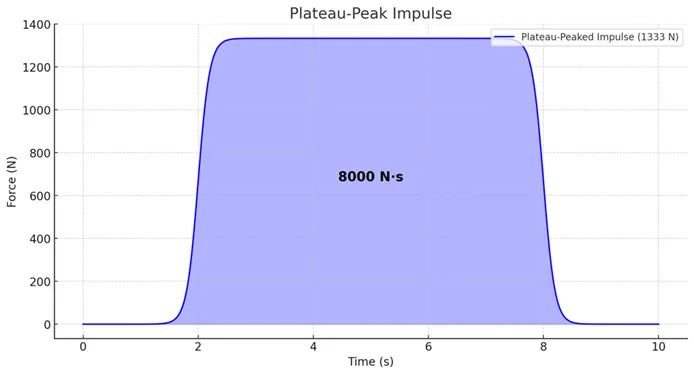
Example of a more duration dominant impulse.
The development of peak force qualities demands a different approach. “Underload implements will have significantly higher peak forces, and rates of force development, resulting in a much sharper, shorter force curve” (Crider, 2025). These lighter implements, with their lower inertia, act as sensitive detectors of technical flaws, providing immediate feedback when sequencing or positioning breaks down. Through this magnification of mechanical errors at higher velocities, athletes can both refine their movement patterns and develop explosive qualities.
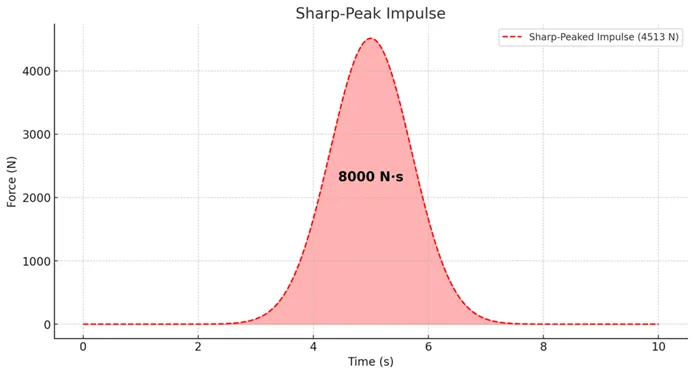
Example of a peak dominant impulse.
The distinction between peak force and total force becomes crucial when emphasizing different implements. Both excessive total force (from implements that are too heavy) and excessive peak force (from maximal effort throws with very light implements) can create injury risk if progressed too aggressively. The key lies in gradually building tolerance to the type of force application that addresses the athlete’s primary limitation while maintaining transfer to competition implements.
This is where intelligent training structure becomes critical. While vertical integration emphasizes developing one specific quality, other qualities still need maintenance stimulus to prevent regression. The solution lies in strategically varying training intensity across sessions — called weekly undulating periodization. High-intensity sessions focus purely on the primary training emphasis — whether that’s force duration with overload implements or peak force with underloads. These focused sessions create the specific adaptations needed for improvement.
However, lower intensity and recovery sessions serve a different but equally important purpose. These sessions maintain overall throwing capability through movement variability — using the full spectrum of implement weights. This variety in lighter sessions serves multiple purposes: it prevents the loss of qualities not currently emphasized, helps maintain movement pattern flexibility, and reduces the risk of overuse from excessive repetition of a single pattern. Think of it like cross-training for a runner — easy days might include swimming or cycling to maintain fitness while reducing stress on running-specific patterns.
This structured variation — focused, single-quality emphasis on high-intensity days combined with broader movement exploration on recovery days — creates an optimal balance. The athlete gets the concentrated stimulus needed for improvement in their primary limitation while maintaining overall throwing capability through varied movement patterns at lower intensities. This focused yet balanced approach typically produces better long-term results in advanced athletes than trying to improve everything simultaneously.
Rest Between Throws
Rest between throws represents one of the most powerful yet underutilized training variables. The duration of rest intervals directly impacts both the type and magnitude of adaptation we can create. Understanding this relationship allows us to better align recovery periods with our intended training outcomes.

Types of rest necessary for different types of training, Viktor Seluyanov.
Viktor Seluyanov’s research helps illuminate two critical training zones that produce distinct adaptations:
Alactic Capacity Training uses shorter rest periods (30–90 seconds) with more sets (10–12). This compressed rest creates progressive muscular fatigue while maintaining high neural output. Think of it like interval training — the shortened recovery means each subsequent effort builds on the fatigue of previous throws. This accumulated fatigue drives adaptations in the muscle’s ability to sustain output, improving work capacity. These shorter rest periods also mirror many game scenarios, particularly with the introduction of pitch clocks.
Alactic Power Training requires longer rest periods (2–5 minutes) with fewer sets (5–6). This extended recovery allows complete restoration of both neural and muscular systems between efforts. It’s analogous to a sprinter taking full recovery between maximum effort runs — the goal is to maintain peak output without accumulating fatigue. This format optimizes the development of pure power and velocity.
The relationship between implement selection and rest periods becomes particularly important when designing training sessions. Impulse duration-dominant training with overload implements typically benefit from shorter rest periods, as the wider force-time curves align well with capacity-focused rest intervals. This connection exists because wider force-time curves create greater muscular fatigue — the extended time under tension means muscle fibers are being recruited and stressed for longer periods during each throw.
Conversely, impulse peak-dominant training with underload implements usually requires longer rest periods. The sharp, narrow force-time curves and high neural demands of lightweight implements need fuller recovery to maintain quality. When we train with underload implements, we’re primarily targeting nervous system adaptations — specifically, how quickly the system can recruit and relax muscle fibers.
This type of neural training places unique demands on the system. Each throw requires precise coordination of rapid muscle fiber recruitment and relaxation, much like a sprinter needs perfect timing to achieve maximum velocity. Just as a sprinter wouldn’t perform maximum-effort sprints with minimal rest, we don’t want to rush between high-intensity throws with underload implements. The nervous system needs adequate recovery time to maintain the quality and precision of these rapid contractions.
When rest periods are too short with underload implements, muscular fatigue can become the limiting factor rather than neural capability. This defeats the purpose of using lighter implements — we’re trying to challenge the speed of muscle recruitment, not the muscles’ endurance. It would be like trying to practice your fastest sprints while already tired from running — you simply can’t access your true speed capabilities in a fatigued state.
Like any training variable, rest periods should be periodized throughout the training cycle. Early phases might emphasize longer rest to optimize absolute output and movement quality. As competition approaches, rest periods can be compressed to enhance specific conditioning. The crucial point is ensuring both qualities — power and capacity — receive appropriate training emphasis through deliberate manipulation of rest intervals.
This balanced approach recognizes that optimal performance requires both the ability to express maximum power and the capacity to sustain that output across multiple efforts. Strategic variation of rest periods helps develop both qualities while maintaining transfer to competition demands.
Let me help structure this real-world example to better illustrate how the principles we’ve discussed come together in practice. Here’s how I would organize this case study:
Josh Hejka: Applying Autoregulation and Vertical Integration
Understanding the athlete’s context is crucial for program design. As a minor league reliever for the Mets, Hejka’s training needs were shaped by several key factors:
– Role as a reliever (frequent, high-intensity outings)
– Early offseason phase focusing on strength development
– Recent completion of competitive season with high throwing frequency
Initial Capacity Phase Design
The program began with a capacity-focused phase that aligned with his concurrent strength training. Following vertical integration principles, we emphasized overload implements (9/7/5oz) during velocity sessions to match the duration-dominant nature of his strength work.
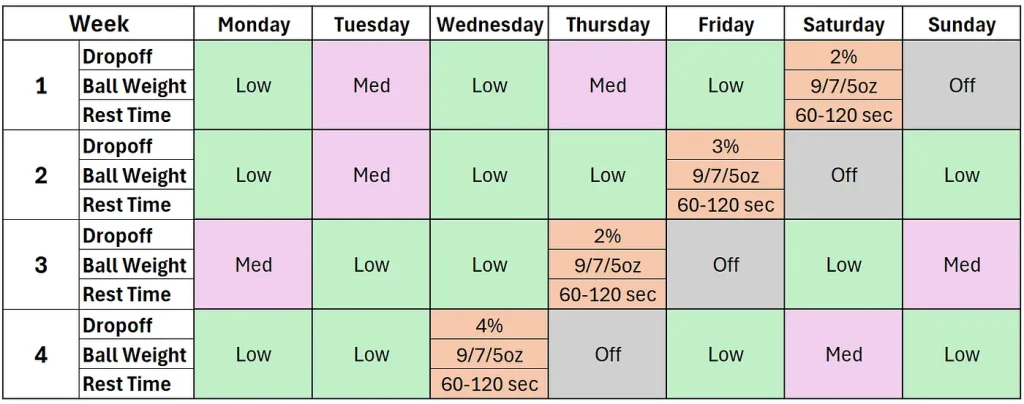
Wave loaded capacity phase for Josh Hejka
This phase featured:
– Once weekly velocity sessions with progressive drop-off targets
– Wave-loading pattern over four weeks (2%, 3%, 2%, 4% velocity drop-offs)
– Extended rest periods between throws despite using heavy implements
This last point might seem counterintuitive — using longer rest periods with overload implements typically associated with shorter rest. However, the goal was to maximize the quality of duration-dominant work rather than building fatigue resistance. Since Hejka would face plenty of compressed rest periods during the season, this phase prioritized his ability to produce maximum force over longer durations without accumulated fatigue interfering.
Transition to Frequency Phase
The second phase shifted focus to more game-specific demands through increased throwing frequency.
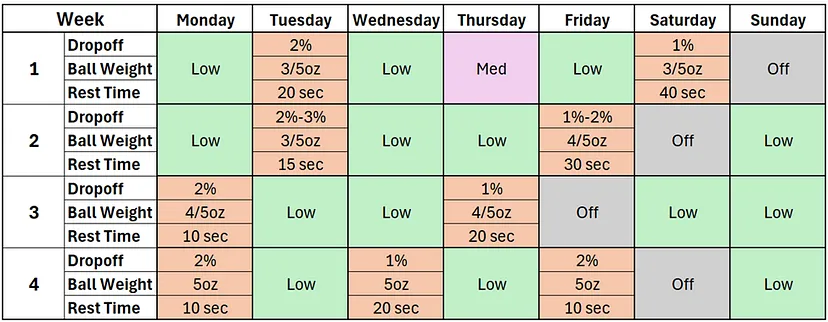
Frequency training plan for Josh Hejka
The frequency phase marked a significant shift in training emphasis, moving toward more game-specific demands through increased throwing frequency. This phase’s comprehensive approach integrated multiple weekly throwing sessions with carefully structured wave-loaded weekly drop-offs and rest durations. The programming implemented weekly undulating periodization in intensity distribution and orchestrated a methodical progression from underload implements to competition weight (5oz) balls. Compared to the previous phase, rest periods were deliberately compressed to better simulate actual game conditions and enhance sport-specific adaptations.
The design of this phase reflected several critical training principles that guided its implementation. Training demands progressed systematically from general to specific, while implement selection evolved from varied options early in the phase to predominantly competition-specific implements. Hejka encountered progressively challenging fatigue management scenarios that closely replicated in-season demands. Throughout this progression, careful attention to drop-off monitoring ensured adherence to autoregulatory principles, maintaining the delicate balance between stimulus and recovery.
This real-world example demonstrates how theoretical principles — vertical integration, autoregulation, and proper rest period manipulation — can be applied systematically to address an athlete’s specific needs and constraints. The program’s progression from capacity development to specific preparation illustrates the importance of proper phase sequencing in throwing program design.
A Standard Framework for Autoregulatory Throwing Programs
Most autoregulatory throwing programs begin with a frequency phase characterized by conservative weekly drop-offs. Starting with just 2–3% weekly velocity decline allows athletes to gradually build workload tolerance. As athletes adapt, we progressively increase the weekly fatigue to around 6%. This steady accumulation of training stress creates residual fatigue over time, effectively transitioning the frequency phase into an accumulation phase.

Example of a capacity phase with wave loaded dropoffs.
Athletes typically demonstrate progressive velocity improvements through the capacity phase, usually peaking around weeks 2–3. This performance peak signals readiness for retesting and beginning the next training cycle. The systematic progression from frequency to capacity phases, guided by careful monitoring of drop-offs and fatigue, allows athletes to build both workload tolerance and absolute performance capabilities while managing fatigue appropriately.
This framework preserves the key principles of autoregulation — individualizing training stress based on performance feedback — while providing enough structure to guide program design decisions. The careful attention to drop-off percentages, implement selection, and phase transitions helps optimize adaptation while managing fatigue effectively.
Conclusion
The evolution of fatigue management in throwing programs represents a significant advancement in sports performance training. By combining the foundational principles of autoregulation with modern understanding of neuromuscular fatigue, coaches can now develop truly individualized programs that optimize both performance and recovery. The key lies in recognizing that fatigue is not simply a limitation to be avoided, but rather a critical training variable that, when properly managed, drives adaptation and improvement.
The integration of careful drop-off monitoring, strategic phase manipulation, and implement variation creates a robust framework for long-term athlete development. This approach moves beyond traditional “one-size-fits-all” programming to account for individual differences in fatigue response and recovery capacity. By carefully balancing frequency and intensity through accumulation and intensification phases, coaches can help athletes push their performance boundaries while maintaining sustainable training practices.
Perhaps most importantly, modern autoregulatory approaches provide a systematic way to quantify and manage what coaches have intuitively understood for generations — that athletes need different stimuli on different days to optimize their development. As our understanding of fatigue management continues to evolve, the principles outlined here provide a solid foundation for developing throwing programs that maximize performance while minimizing injury risk. The future of throwing program design lies not in rigid adherence to predetermined volumes or intensities, but in the intelligent application of autoregulatory principles guided by careful monitoring of individual response to training stress.
References
Buchenholz, D. (2004). The Best Sports Training Book Ever. Inno-Sport Publishing Group.
Crider, B. (2025, January 10). Constraint based learning heuristics for throwers. Crider Performance. https://www.criderperformance.com/blog/constraints-based-learning-heuristics-for-throwers
Gandevia, S. C. (2001). Spinal and supraspinal factors in human muscle fatigue. Physiological Reviews, 81(4), 1725–1789. https://doi.org/10.1152/physrev.2001.81.4.1725
Issurin, V., & Yessis, M. (2008). Block periodization: Breakthrough in sports training. Ultimate Athlete Concepts.
Jamieson, J. (2009). Ultimate MMA conditioning. Performance Sports Inc.
Mann, B. (2011). APRE: The Scientifically Proven Fastest Way to Get Strong.
Selye, H. A Syndrome produced by Diverse Nocuous Agents. Nature 138, 32 (1936).
Verkhoshansky, Y., & Siff, M. C. (2009). Supertraining. Verkhoshansky ; Distributed by Ultimate Athlete Concepts.
Comment section